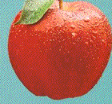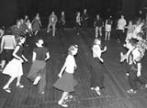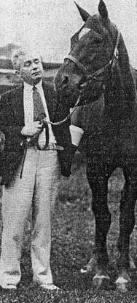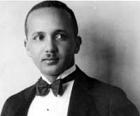
"When and how did New York City come to be called "The Big
Apple'?"
This is by far the most frequently asked question—and the
most hotly debated—to reach our New York History Hotline.
There are actually several answers (nothing about New York
City is simple, after all). All are explained below, with the last
word going, appropriately enough, to SNYCH’s own Joe Zito,
one of this burg’s finest purveyors of high-quality urban history.
A veteran both of New York City’s inimitable press corps and its
police department, Joe—happily for us—is able to provide
authoritative first-hand testimony on this topic. Read on!
Various accounts have traced the “Big Apple” expression to
Depression-Era sidewalk apple vendors, a Harlem night
club, and a popular 1930s dance known as the “Big Apple.”
One fanciful version even linked the name with a notorious 19th-
century procuress!
In fact, it was the jazz musicians of the 1930s and ‘40s who put
the phrase into more or less general circulation. If a jazzman
circa 1940 told you he had a gig in the “Big Apple,” you knew
he had an engagement to play in the most coveted venue of all,
Manhattan, where the audience was the biggest, hippest, and
most appreciative in the country.
The older generation of jazzmen specifically credit Fletcher
Henderson, one of the greatest of the early Big Band leaders
and arrangers, with popularizing it, but such things are probably
impossible to document. Be that as it may, the ultimate source
actually was not the jazz world, but the racetrack.
As Damon Runyon (among many others) cheerfully pointed out,
New York in those days offered a betting man a lot of places to
go broke. There were no fewer than four major tracks nearby,
and it required no fewer than three racing journals to cover
such a lively scene—The Daily Racing Form (which still
survives on newsstands today) and The Running Horse and
The New York Morning Telegraph (which do not)—and the
ultimate credit for marrying New York to its durable catchphrase
goes to columnist John J. FitzGerald, who wrote for the
Telegraph for over 20 years.
Joe Zito, who joined the paper as a young man some 70-plus
years ago, recently reminisced about Jack Fitzgerald and his
times.
In FitzGerald’s honor (and due largely to the strenuous efforts
of attorney-etymologist Barry Popick, who, like the columnist,
immigrated to NYC from upstate New York) a street sign
reading “Big Apple Corner” was installed at Broadway and
West 54th Street in 1997, near the hotel where FitzGerald died
in poverty in 1963—although a location near the old Telegraph
office might arguably have been a happier spot for it.
Despite its turf-related origins, by the 1930s and ’40s, the
phrase had become firmly linked to the city’s jazz scene. “Big
Apple” was the name both of a popular night club at West 135th
Street and Seventh Avenue in Harlem and a jitterbug-style
group dance that originated in the South, became a huge
phenomenon at Harlem’s great Savoy Ballroom and rapidly
spread across the country. (Neat cultural footnote: the great
African-American cinema pioneer Oscar Micheaux liked to
use the Big Apple as a venue for occasional screenings of his
latest feature film or documentary.)
A film short called The Big Apple came out in 1938, with an all-
Black cast featuring Herbert “Whitey” White’s Lindy Hoppers,
Harlem’s top ballroom dancers in the Swing Era. In a book
published the same year, bandleader Cab Calloway used the
phrase "Big Apple" to mean "the big town, the main stem,
Harlem." Anyone who loved the city would have readily agreed
with Jack FitzGerald: “There's only one Big Apple. That's New
York."
The term had grown stale and was in fact generally forgotten by
the 1970s. Then Charles Gillett, head of the New York
Convention & Visitors Bureau, got the idea of reviving it.
The agency was desperately trying to attract tourists to the
town Mayor John Lindsay had dubbed “Fun City,” but which
had become better-known for its blackouts, strikes, street crime
and occasional riots. What could be a more wholesome symbol
of renewal than a plump red apple?
The city's industrial-strength “I ♥ NY” campaign was launched
toward the end of the Lindsay administration in 1971, complete
with a cheerful Big Apple logo in innumerable forms (lapel pins,
buttons, bumper stickers, refrigerator magnets, shopping bags,
ashtrays, ties, tie tacks, “Big Apple” T-shirts, etc.).
Apparently Gillett was on to something, because at this writing,
over 35 years later, the campaign he launched—it won him a
Tourism Achievement award in 1994, by the way—is still going
strong.
Click here to hear Joe Zito’s account.
Apple'?"
This is by far the most frequently asked question—and the
most hotly debated—to reach our New York History Hotline.
There are actually several answers (nothing about New York
City is simple, after all). All are explained below, with the last
word going, appropriately enough, to SNYCH’s own Joe Zito,
one of this burg’s finest purveyors of high-quality urban history.
A veteran both of New York City’s inimitable press corps and its
police department, Joe—happily for us—is able to provide
authoritative first-hand testimony on this topic. Read on!
Various accounts have traced the “Big Apple” expression to
Depression-Era sidewalk apple vendors, a Harlem night
club, and a popular 1930s dance known as the “Big Apple.”
One fanciful version even linked the name with a notorious 19th-
century procuress!
In fact, it was the jazz musicians of the 1930s and ‘40s who put
the phrase into more or less general circulation. If a jazzman
circa 1940 told you he had a gig in the “Big Apple,” you knew
he had an engagement to play in the most coveted venue of all,
Manhattan, where the audience was the biggest, hippest, and
most appreciative in the country.
The older generation of jazzmen specifically credit Fletcher
Henderson, one of the greatest of the early Big Band leaders
and arrangers, with popularizing it, but such things are probably
impossible to document. Be that as it may, the ultimate source
actually was not the jazz world, but the racetrack.
As Damon Runyon (among many others) cheerfully pointed out,
New York in those days offered a betting man a lot of places to
go broke. There were no fewer than four major tracks nearby,
and it required no fewer than three racing journals to cover
such a lively scene—The Daily Racing Form (which still
survives on newsstands today) and The Running Horse and
The New York Morning Telegraph (which do not)—and the
ultimate credit for marrying New York to its durable catchphrase
goes to columnist John J. FitzGerald, who wrote for the
Telegraph for over 20 years.
Joe Zito, who joined the paper as a young man some 70-plus
years ago, recently reminisced about Jack Fitzgerald and his
times.
In FitzGerald’s honor (and due largely to the strenuous efforts
of attorney-etymologist Barry Popick, who, like the columnist,
immigrated to NYC from upstate New York) a street sign
reading “Big Apple Corner” was installed at Broadway and
West 54th Street in 1997, near the hotel where FitzGerald died
in poverty in 1963—although a location near the old Telegraph
office might arguably have been a happier spot for it.
Despite its turf-related origins, by the 1930s and ’40s, the
phrase had become firmly linked to the city’s jazz scene. “Big
Apple” was the name both of a popular night club at West 135th
Street and Seventh Avenue in Harlem and a jitterbug-style
group dance that originated in the South, became a huge
phenomenon at Harlem’s great Savoy Ballroom and rapidly
spread across the country. (Neat cultural footnote: the great
African-American cinema pioneer Oscar Micheaux liked to
use the Big Apple as a venue for occasional screenings of his
latest feature film or documentary.)
A film short called The Big Apple came out in 1938, with an all-
Black cast featuring Herbert “Whitey” White’s Lindy Hoppers,
Harlem’s top ballroom dancers in the Swing Era. In a book
published the same year, bandleader Cab Calloway used the
phrase "Big Apple" to mean "the big town, the main stem,
Harlem." Anyone who loved the city would have readily agreed
with Jack FitzGerald: “There's only one Big Apple. That's New
York."
The term had grown stale and was in fact generally forgotten by
the 1970s. Then Charles Gillett, head of the New York
Convention & Visitors Bureau, got the idea of reviving it.
The agency was desperately trying to attract tourists to the
town Mayor John Lindsay had dubbed “Fun City,” but which
had become better-known for its blackouts, strikes, street crime
and occasional riots. What could be a more wholesome symbol
of renewal than a plump red apple?
The city's industrial-strength “I ♥ NY” campaign was launched
toward the end of the Lindsay administration in 1971, complete
with a cheerful Big Apple logo in innumerable forms (lapel pins,
buttons, bumper stickers, refrigerator magnets, shopping bags,
ashtrays, ties, tie tacks, “Big Apple” T-shirts, etc.).
Apparently Gillett was on to something, because at this writing,
over 35 years later, the campaign he launched—it won him a
Tourism Achievement award in 1994, by the way—is still going
strong.
Click here to hear Joe Zito’s account.
| — The Society for New York City History Education Committee |
| Copyright SNYCH © 2005 |

|
|
| Celebrate New York! |
“In the early 1930s I got my first job as a rewrite man and a
copy reader for the Morning Telegraph. The Telegraph at that
time was situated on West 24th Street, and the site is now
part of the parking lot of the huge Penn South complex.
John FitzGerald—we called him Jack—was the feature writer
for the paper, and he covered the races in New York State. At
that time, in addition to Belmont Park and Aqueduct, there was
Jamaica Race Track, the Empire City Track up in Yonkers
[now Yonkers Raceway], and of course Saratoga.
Jack was the first writer to use the term ‘The Big Apple’ in
print, maybe ten years before I started at the paper—in fact,
he called his regular column ‘Around the Big Apple.’ He told us
that he had heard it from the Black stable boys at who
followed the horses to the small quarter-mile tracks in New
Orleans and all over the East and the Middle West.
They were so glad now to come to New York, where the big
money was. The city was so huge to them and so full of
opportunity that they called it the ‘Big Apple.’”
copy reader for the Morning Telegraph. The Telegraph at that
time was situated on West 24th Street, and the site is now
part of the parking lot of the huge Penn South complex.
John FitzGerald—we called him Jack—was the feature writer
for the paper, and he covered the races in New York State. At
that time, in addition to Belmont Park and Aqueduct, there was
Jamaica Race Track, the Empire City Track up in Yonkers
[now Yonkers Raceway], and of course Saratoga.
Jack was the first writer to use the term ‘The Big Apple’ in
print, maybe ten years before I started at the paper—in fact,
he called his regular column ‘Around the Big Apple.’ He told us
that he had heard it from the Black stable boys at who
followed the horses to the small quarter-mile tracks in New
Orleans and all over the East and the Middle West.
They were so glad now to come to New York, where the big
money was. The city was so huge to them and so full of
opportunity that they called it the ‘Big Apple.’”

Best known today as
Benny Goodman’s
finest arranger,
Fletcher Henderson
was a great
bandleader in his
own right and
probably the man
who did most to put
the “Big Apple”
nickname into wide
circulation.
Benny Goodman’s
finest arranger,
Fletcher Henderson
was a great
bandleader in his
own right and
probably the man
who did most to put
the “Big Apple”
nickname into wide
circulation.
A group dance called
the Big Apple was
popular in the era of
the Shag and the Lindy
Hop. A whimsical sign
(below) still marks the
site of the Big Apple
club at W. 135th St.
and Seventh Avenue.
the Big Apple was
popular in the era of
the Shag and the Lindy
Hop. A whimsical sign
(below) still marks the
site of the Big Apple
club at W. 135th St.
and Seventh Avenue.
Turf scribe Jack
FitzGerald (below, left)
dubbed his long-
running column
“Around the Big
Apple”; by his own
account, he’d
borrowed the term from
“two dusky stable
hands” overheard after
a race at the Fair
Grounds in New
Orleans.
FitzGerald (below, left)
dubbed his long-
running column
“Around the Big
Apple”; by his own
account, he’d
borrowed the term from
“two dusky stable
hands” overheard after
a race at the Fair
Grounds in New
Orleans.


| Links |
| NYC History |


